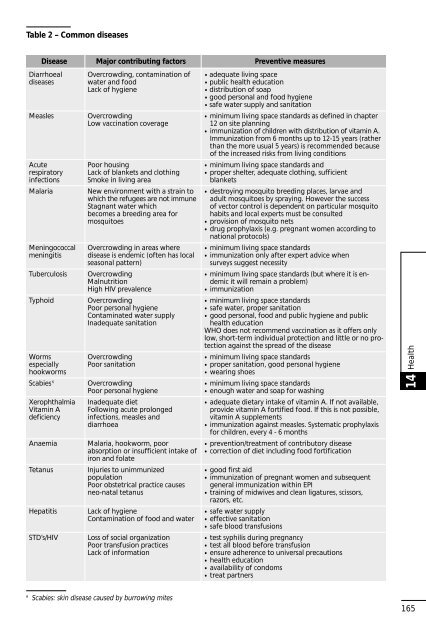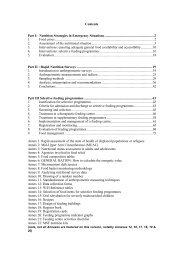UNHCR Handbook for Emergencies - UNHCR eCentre
UNHCR Handbook for Emergencies - UNHCR eCentre
UNHCR Handbook for Emergencies - UNHCR eCentre
You also want an ePaper? Increase the reach of your titles
YUMPU automatically turns print PDFs into web optimized ePapers that Google loves.
Table 2 – Common diseases<br />
Disease Major contributing factors Preventive measures<br />
Diarrhoeal<br />
diseases<br />
Measles<br />
Acute<br />
respiratory<br />
infections<br />
Malaria<br />
Meningococcal<br />
meningitis<br />
Tuberculosis<br />
Typhoid<br />
Worms<br />
especially<br />
hookworms<br />
Scabies 6<br />
Xerophthalmia<br />
Vitamin A<br />
deficiency<br />
Anaemia<br />
Tetanus<br />
Hepatitis<br />
STD’s/HIV<br />
Overcrowding, contamination of<br />
water and food<br />
Lack of hygiene<br />
Overcrowding<br />
Low vaccination coverage<br />
Poor housing<br />
Lack of blankets and clothing<br />
Smoke in living area<br />
New environment with a strain to<br />
which the refugees are not immune<br />
Stagnant water which<br />
becomes a breeding area <strong>for</strong><br />
mosquitoes<br />
Overcrowding in areas where<br />
disease is endemic (often has local<br />
seasonal pattern)<br />
Overcrowding<br />
Malnutrition<br />
High HIV prevalence<br />
Overcrowding<br />
Poor personal hygiene<br />
Contaminated water supply<br />
Inadequate sanitation<br />
Overcrowding<br />
Poor sanitation<br />
Overcrowding<br />
Poor personal hygiene<br />
Inadequate diet<br />
Following acute prolonged<br />
infections, measles and<br />
diarrhoea<br />
Malaria, hookworm, poor<br />
absorption or insufficient intake of<br />
iron and folate<br />
Injuries to unimmunized<br />
population<br />
Poor obstetrical practice causes<br />
neo-natal tetanus<br />
Lack of hygiene<br />
Contamination of food and water<br />
Loss of social organization<br />
Poor transfusion practices<br />
Lack of in<strong>for</strong>mation<br />
6 Scabies: skin disease caused by burrowing mites<br />
• adequate living space<br />
• public health education<br />
• distribution of soap<br />
• good personal and food hygiene<br />
• safe water supply and sanitation<br />
• minimum living space standards as defined in chapter<br />
12 on site planning<br />
• immunization of children with distribution of vitamin A.<br />
Immunization from 6 months up to 12-15 years (rather<br />
than the more usual 5 years) is recommended because<br />
of the increased risks from living conditions<br />
• minimum living space standards and<br />
• proper shelter, adequate clothing, sufficient<br />
blankets<br />
• destroying mosquito breeding places, larvae and<br />
adult mosquitoes by spraying. However the success<br />
of vector control is dependent on particular mosquito<br />
habits and local experts must be consulted<br />
• provision of mosquito nets<br />
• drug prophylaxis (e.g. pregnant women according to<br />
national protocols)<br />
• minimum living space standards<br />
• immunization only after expert advice when<br />
surveys suggest necessity<br />
• minimum living space standards (but where it is endemic<br />
it will remain a problem)<br />
• immunization<br />
• minimum living space standards<br />
• safe water, proper sanitation<br />
• good personal, food and public hygiene and public<br />
health education<br />
WHO does not recommend vaccination as it offers only<br />
low, short-term individual protection and little or no protection<br />
against the spread of the disease<br />
• minimum living space standards<br />
• proper sanitation, good personal hygiene<br />
• wearing shoes<br />
• minimum living space standards<br />
• enough water and soap <strong>for</strong> washing<br />
• adequate dietary intake of vitamin A. If not available,<br />
provide vitamin A <strong>for</strong>tified food. If this is not possible,<br />
vitamin A supplements<br />
• immunization against measles. Systematic prophylaxis<br />
<strong>for</strong> children, every 4 - 6 months<br />
• prevention/treatment of contributory disease<br />
• correction of diet including food <strong>for</strong>tification<br />
• good first aid<br />
• immunization of pregnant women and subsequent<br />
general immunization within EPI<br />
• training of midwives and clean ligatures, scissors,<br />
razors, etc.<br />
• safe water supply<br />
• effective sanitation<br />
• safe blood transfusions<br />
• test syphilis during pregnancy<br />
• test all blood be<strong>for</strong>e transfusion<br />
• ensure adherence to universal precautions<br />
• health education<br />
• availability of condoms<br />
• treat partners<br />
Health<br />
14<br />
165



